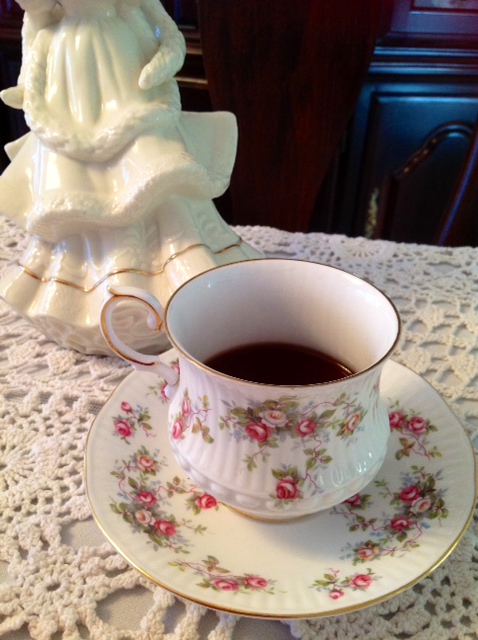After a steady diet of bagged tea in NYC, I rummaged through my bag to ease back into puerh. I brought out the Gold Brick sample given to me by Ira as "Mystery Tea A"- the Gold Brick is a pleasant smooth shu tolerant of mis-brewing. For kicks, I thought I would serve it in my mother's oldest china set. I broke this rose patterned cup as a little girl and I tried to attach back the handle with superglue without my mother knowing. Of course nothing ever escapes a mother's eagle eyes.
Shu just tastes all wrong in dainty floral bone china so I dug out more appropriate cups. The tea tastes very different in all
three even though these cups are fully glazed. It's not just feeling and mood. At home my porous unglazed teaware definitely influences taste in a noticeable way but my glazed teaware tends to taste about same.
The shu tastes rather thin in the bone china while the celadon glaze gives the shu the fullest roundest flavor. In fact I can only taste the noted Haiwan creaminess with these Korean cups. The shape as in wine glasses is an important determinant in influencing taste in dispersing the tea smells. However I'm guessing it's the variations in the glazed surfaces that are responsible for the difference. The cracks in the celadon are somehow ideal for at least this type of shu. (These green cups are going home with me for further experimentation that is... ) I guess shu benefits from an angular surface to open up the molecules.
More on the tea which I will need some help from Ira. Ira told me she was told the Gold Brick was a special edition and I remember seeing it in a fancy box. I vaguely remember that it had some Banzhang(SBZ not LBZ?) leaves as well. This shu is a gong ting style with tiny leaves and tastes similar to the 2006 Haiwan Peacock Shu and has a light light lingering taste. Still this shu is a bit too young for my taste as from time to time I get a faintest hint of wodui- not obvious but still present enough to cause a wee bit of consternation from me.
The shu tastes rather thin in the bone china while the celadon glaze gives the shu the fullest roundest flavor. In fact I can only taste the noted Haiwan creaminess with these Korean cups. The shape as in wine glasses is an important determinant in influencing taste in dispersing the tea smells. However I'm guessing it's the variations in the glazed surfaces that are responsible for the difference. The cracks in the celadon are somehow ideal for at least this type of shu. (These green cups are going home with me for further experimentation that is... ) I guess shu benefits from an angular surface to open up the molecules.
More on the tea which I will need some help from Ira. Ira told me she was told the Gold Brick was a special edition and I remember seeing it in a fancy box. I vaguely remember that it had some Banzhang(SBZ not LBZ?) leaves as well. This shu is a gong ting style with tiny leaves and tastes similar to the 2006 Haiwan Peacock Shu and has a light light lingering taste. Still this shu is a bit too young for my taste as from time to time I get a faintest hint of wodui- not obvious but still present enough to cause a wee bit of consternation from me.


There is not much info on the box, except it was made with specially chosen Yunnan daye Lao shu (old tree) puerh leaves. Produced in Jan 2011. Lao tong zhi. That's all.
ReplyDeleteMaybe its still a bit young.
I broke something and glued it back without anyone noticing it until my little sister told on me! :)
ReplyDeleteIra-
I'm thinking there might be a sprinkling of old tree because that lingering taste is inconsistent but still sets it slightly apart from other shus.
H
P.s. Perhaps your little sister was too honest. At least she didn't use the broken cup as blackmail.
This comment has been removed by the author.
ReplyDeleteHaHa - very clever in the bone china. I'll have to give this a try, as well. By the way, do you know the maker of the gold brick pu-erh? I have a gold brick from Nanjing Fenghuang Ecological Tea Factory and I just wondered if it were the same.
ReplyDeleteSteph- This sample was from Haiwan (LTZ=Lao Tong Zhi). Gold brick probably means it's got golden tips. Brick form used to mean lesser quality leaves than beengs and tuos although I think premium bricks are being made these days.
DeleteH